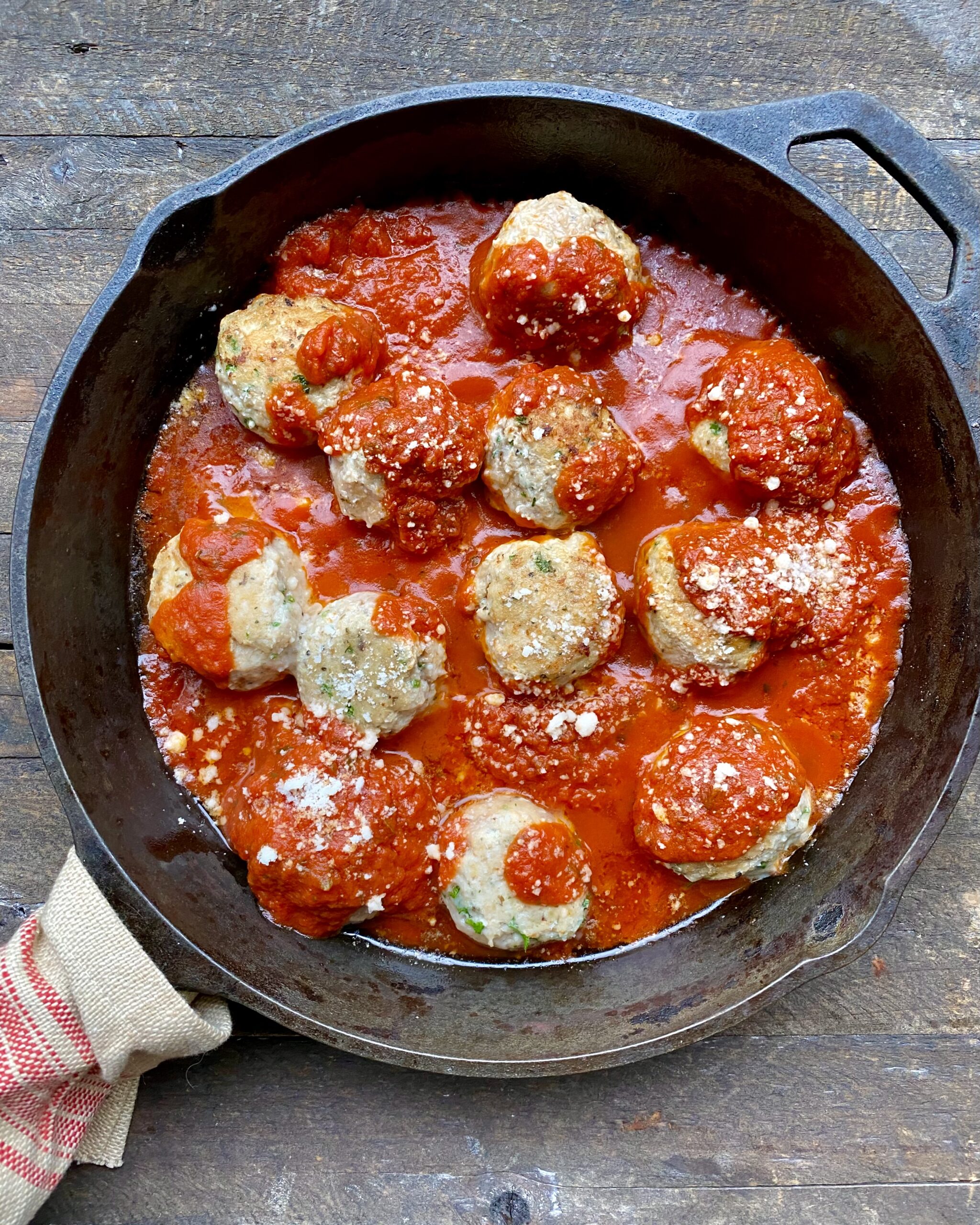Well, hello, from my new home in Bethesda! Russ and I moved just over 2 weeks ago, right outside of DC.
Going from suburban living to city living has many perks! We love that this area has so much to do within walking distance (restaurants, shops, etc)–and yet, in a few minutes, we can be lost riding our bikes on a beautiful tree lined bike path or hiking in the woods on the side of the Potomac river.  It’s been a minute–but I did want to share this meatball recipe that I posted on Instagram a while back. I realize not everyone uses social media, and this recipe is SO darn good not to share here too.
It’s been a minute–but I did want to share this meatball recipe that I posted on Instagram a while back. I realize not everyone uses social media, and this recipe is SO darn good not to share here too.
Here are the meatballs simmering in tomato sauce:
Personally, I like to make a low FODMAP chicken, wine and lemon sauce and simmer the meatballs in this type of sauce and serve over rice.
But, my family really loves these meatballs in traditional pasta sauce best. I work with FODY foods (disclaimer) but honestly, their low FODMAP pasta sauces can’t be beat if you are looking for a very flavorful and authentic gluten free and low FODMAP sauce to pair with this recipe.
.
Ingredients
- 1 pound ground chicken breast
- 3 tablespoon garlic infused oil ( if you tolerate garlic- omit the 1 tablespoon oil added to meatball mixture and add 1-2 minced garlic cloves)
- 1 large egg
- 1/2 cup gluten free plain breadcrumbs ( use wheat breadcrumbs- if you tolerate them)
- 1/3 cup grated pecorino Romano
- 1/4 cup chopped curly parsley
- 3/4 teaspoon dried basil
- 1/2 teaspoon dried oregano
- 1/4-1/2 teaspoon crushed red pepper flakes ( optional, but we love the little kick of heat)
- Salt & pepper, to taste ( about 1/4 teaspoon each)
- For simmer sauce: 1) Marinara: 2 cups low FODMAP/gluten free marinara sauce or 2) prepare a lemon white wine sauce with 1 cup low FODMAP + gluten free chicken broth, 1/2 cup dry white wine, 2 tablespoons lemon juice, 1 tablespoon garlic infused oil and 1 tablespoon minced parsley.
Instructions
- In medium bowl, add ground chicken, 1 tablespoon garlic infused oil, egg, bread crumbs, Romano, parsley, basil, oregano, pepper flakes, salt and pepper.
- Blend mixture together until ingredients are evenly distributed.
- Shape into 1 1/2 inch diameter meatballs. Add 2 tablespoons garlic infused oil to medium cast iron skillet ( or similar)- over medium heat.
- Brown meatballs on all sides.
- Pull meatballs off heat- then drizzle with 2 cups low FODMAP tomato basil pasta sauce. Put cover over skillet and simmer for 10 minutes over medium-low heat until meatballs are cooked through.
- Serve over suitable pasta. Sprinkle with extra Romano if desired.
- Note if choosing to use a Lemon + wine sauce, simple simmer meatballs in mixture of: 1 cup low FODMAP gluten free chicken broth with 1/2 cup dry white wine, 2 tablespoons fresh lemon juice, 1 tablespoon garlic infused olive oil and 1 tablespoon minced parsley.




June Wilson
I like to bake my meatballs in the oven instead. Would this work…and at what temperature for how long?
katescarlata
Absolutely, can bake these. I haven’t baked this recipe yet–would try 375 degrees F for 20 minutes (turn meatballs mid cooking time)–make sure cooked through–AFTER you simmer in sauce.
Sandy
Congratulations on your new home! It sounds just wonderful! Just printed out this recipe. Thank you for sharing!
katescarlata
You are most welcome–and thank you!
Barbara Ferreira
You moved?! Congratulations on your new home. Will you still be visiting Maine? Recipe looks awesome.
katescarlata
Hey Barb! Good to hear from you! Yes, we moved to Bethesda. I still have my home in Mass and Maine—will keep Maine cottage (hope to run into you there again next summer!) and eventually sell my MA home. Stay well!!
Linda Bryan
Remember…wheat flour breads made with a starter are low-FODMAP. This means that it is worthwhile to collect heels and other remnant crumbs from French bread or sourdough for dried bread uses such as meatballs. This crumb of info (pun intended) was incredibly liberating information when a nutritionist taught me this.
The baker in my local chainstore grocery tells me that that the same starter dough is used in their bulk baking “Italian” bread, French bread, sourdough, and “Vienna” bread. Mind-blowing because now I can confidently shop their occasional special prices. I still don’t eat a lot of wheat flour breads of any sort at the same meal, but knowing about how bacteria in the starter eats the fructans in the wheat has given me significant power to bring more variety into my meals.
On the other hand, gluten is not a problem for us in tomato sauces, but your readers may have trouble with concentrated tomatoes in sauces because each tomato does contain some fructose and there are a lot of them in the sauce. (Another insight from my nutritionist.). Traditional Italian sauces were not made with our modern sweeter tomatoes, so storebought sauces can have a much higher FODMAP load, sigh. (If you look at old old Italian recipes, the cook added a spoon or two of sugar because the sauce was NOT sweet.) Some years ago I approached the Minnesota Extension Service regarding low-sugar tomatoes for homemade tomato sauces and they were flummoxed, because common varieties have been hybridized for sweetness. They recommended “heritage” tomatoes because they precede the hybridization adventures of the later 20th century. For our home garden, our family avoids most moderrn varieties of tomatoes but we sure grow some interesting oldies and they make terrific sauce. Yes, I use onion- and garlic-infused oil in the sauces.
Best of all, if I can keep the FODMAP level low enough in the cheeses, sauces, and proteins, I can splurge on real wheat flour noodles for Italian recipes. So much more satisfying than “gluten free” noodles because they remain the same shape even as leftovers and they have “mouthfeel” aspects that keep me from feeling martyred by my gut conditions.
katescarlata
Thanks for your comment, Linda. Just as a friendly reminder, wheat bread made with a sourdough starter may or may not be Low FODMAP, the key here is that the bread is slow-leavened. Often commercial breads contain baker’s yeast–which speeds up the process and does not allow too much time for the fructans to be consumed by the yeast in the sourdough culture. It can be a bit of a trial and error process to find what works for each individual.